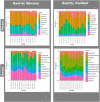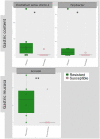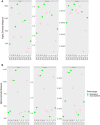Microbial community in resistant and susceptible Churra sheep infected by Teladorsagia circumcincta
- PMID: 36271016
- PMCID: PMC9587209
- DOI: 10.1038/s41598-022-21058-x
Microbial community in resistant and susceptible Churra sheep infected by Teladorsagia circumcincta
Abstract
Gastrointestinal nematodes (GIN) are a major threat to health and welfare in small ruminants worldwide. Teladorsagia circumcincta is a nematode that inhabits the abomasum of sheep, especially in temperate regions, causing important economic losses. Given that T. circumcincta and microbiome share the same niche, interactions between them and the host are expected. Although it is known that within a sheep breed there are animals that are more resistant than others to infection by GIN, it is not known if the microbiome influences the phenotype of these animals. Under this condition, 12 sheep were classified according to their cumulative faecal egg count (cFEC) at the end of a first experimental infection, 6 as resistant group (RG) and 6 as susceptible group (SG) to T. circumcincta infection. Then, all sheep were experimentally infected with 70,000 L3 of T. circumcincta and at day 7 days post-infection were euthanized. At necropsy, gastric mucosa and gastric content from abomasum were collected to extract bacterial DNA and sequence V3-V4 region from 16S rRNA gene using Ilumina technology. After bioanalysis performed, results showed that α-diversity and β-diversity remained similar in both groups. However, resistant phenotype sheep showed a higher number of bacteria butyrate-fermenting species as Clostridium sensu stricto 1 (abundance in RG: 1.29% and in SG: 0.069%; p = 0.05), and Turicibacter (abundance in RG: 0.31% and in SG: 0.027%; p = 0.07) in gastric content but also Serratia spp in gastric mucosa (abundance in RG: 0.12% and in SG: 0.041%; p = 0.07). A trend towards a significant negative correlation between cFEC and Clostridium sensu stricto 1 abundance in gastric content was detected (r = - 0.537; p = 0.08). These data suggest that microbiome composition could be another factor associated with the development of the resistant phenotype modifying the interaction with the host and the in last instance affecting the individual risk of infection.
© 2022. The Author(s).
Conflict of interest statement
The authors declare no competing interests.
Figures




References
-
- Stear MJ, Doligalska M, Donskow-Schmelter K. Alternatives to anthelmintics for the control of nematodes in livestock. Parasitology. 2007;134:139–151. - PubMed
-
- Halliday AM, Smith WD. Attempts to immunize sheep against Teladorsagia circumcincta using fourth-stage larval extracts. Parasite Immunol. 2011;33:554–560. - PubMed
-
- Charlier J, van der Voort M, Kenyon F, Skuce P, Vercruysse J. Chasing helminths and their economic impact on farmed ruminants. Trends Parasitol. 2014;30:361–367. - PubMed
-
- Charlier J, et al. Initial assessment of the economic burden of major parasitic helminth infections to the ruminant livestock industry in Europe. Prev. Vet. Med. 2020;182:105103. - PubMed
MeSH terms
Substances
LinkOut - more resources
Full Text Sources
Miscellaneous

